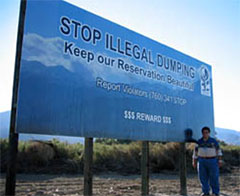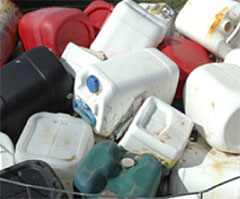Contact Pacific Southwest Waste Program
Pacific Southwest, Region 9
Serving: Arizona, California, Hawaii, Nevada, Pacific Islands, Tribal Nations
Tribal Solid Waste Outreach Materials

On This Page:
- Publications
- General Waste Management and Recycling Issues
- Household Hazardous Waste
- Illegal Dumping
- Electronic Waste
- Medical Waste
- Open Burning
- Used Oil
- Composting
Public education and community outreach are integral parts of any tribal solid waste management program. Well planned education and outreach initiatives can help generate understanding and support for waste management issues in your tribe.
The publications listed on this page can be used for reference when creating tribal-specific outreach materials or can be printed and handed out directly to tribal members. If you have a tribal solid waste outreach publication or solid waste curricula you would like to share with other tribes, email Michelle Baker (baker.michelle@epa.gov) and we’ll include it on this page. Additionally, if you have ideas on new solid waste brochures that you would like developed by EPA as customizable documents, please contact Michelle Baker (baker.michelle@epa.gov).
For general information about conducting solid waste outreach for your tribe, see the Tribal Decision-Maker’s Guide to Solid Waste Management, Chapter 6: Public Education and Outreach.
For general waste management information resources for teachers, including curriculum, activities, games, and other educational materials, see EPA’s Resources for Waste Education Web Site, EPA’s Eco-Portal for Teachers or Eisenhower National Clearinghouse’s K-12 Math and Science Teachers’ Resources. For a review of various solid waste curriculums, see California Integrated Waste Management Board’s Environmental Education: Compendium for Integrated Waste Management.
Publications
Closing Small Tribal Landfills and Open Dumps, How to Design Environmentally Safe Covers, Including additional design guidance for arid regions
This guidance is intended to help tribal public works managers, environmental managers, and tribal leadership determine an appropriate final cover profile for closing small landfills and open dump sites on tribal lands, and provides design steps for doing so. This document includes updated information from previous guidance documents for closing small landfills and open dump sites within arid regions.
Abandon Vehicle Guide
This guide, Developing an Abandoned Vehicle Program for Tribal Governments, provides a step-by-step process for developing an abandoned vehicle clean-up program and is intended to assist tribal leaders pursuing this type of program.
- Developing an Abandoned Vehicle Program for Tribal Governments (15 pp, 1.2M, About PDF)
- Brochure for Tribal Community Members: Removal of Non-operative or Abandoned Vehicles (fill-in) (Microsoft Publisher file) This template can be used to create your own abandoned vehicle guide brochure by entering your Tribe’s specific information before printing. If you do not have access to Microsoft Publisher or are having technical difficulties, contact your tribal solid waste team representative and he or she will assist you.
Costing Tool for Solid Waste Collection Programs
The Tribal Solid Waste Costing Tool and accompanying spreadsheet are intended to help tribal leaders make decisions about solid waste collection and disposal and to determine feasibility for implementing the following programs:
- Tribally-operated collection service
- Tribally-operated transfer station
- Tribally-operated landfill
- Tribal Solid Waste Program Costing Tool (32 pp, 2.2M)
- Tribal Solid Waste Program Cost Tool Spreadsheet (.xls, 52K)
Please contact Michelle Baker, baker.michelle@epa.gov for any question you may have at: 415-972-3206.
EPA Publications Related to Tribal Solid Waste
Indian Health Service 2012 Open Dump Report (XLS) (500K)
General Waste Management and Recycling Issues
For more information about waste management and recycling, check out EPA’s Office of Solid Waste.
Brochures and Outreach Documents

Where Your Waste Goes: A Waste Management Guide for Tribal Members (PDF) (2 pp, 357K)
This brochure gives general tips on what to do with specific types of waste including, recyclables, compostables, bulky waste, electronic waste, and household hazardous waste.Where Your Waste Goes: A Waste Management Guide for Tribal Members (fill-in) (Microsoft Publisher file)
This template can be used to create your own waste management brochure by entering your tribe’s specific information before printing. If you do not have access to Microsoft Publisher or are having technical difficulties, contact your tribal solid waste team representative and he or she will assist you.Recycling Kit and Posters
For bottle and can recycling from CalRecycle website.
11 Easy Ways to Cut Your Trash in Half
Brochure from California Integrated Waste Management Board that depicts simple ways that the average person can help limit the amount of waste going to landfills, including grasscycling, composting, xeriscaping, recycling, buying recycled, reusing, etc. Also available in Spanish.

Planet Protectors Club for Kids Solid Waste activities, coloring books, and games for kids.
Waste Prevention and Recycling Posters and Stickers
Posters and stickers available from the California Integrated Waste Management Board to help California businesses, local governmental agencies, and educational institutions coordinate and promote waste reduction efforts.
These Come From Trees
Stickers to prevent paper waste.
Curriculum
EPA Solid Waste and Recycling Curriculum
MOBIUS Curriculum: Understanding the Waste Cycle
This curriculum aimed at teachers of grades 4-6 covers composting, the history of garbage, packaging issues, recycling, reuse, solid waste management, source reduction, and sustainability.
The No Waste Anthology: A Teacher’s Guide to Environmental Activities, K through 12
This curriculum from California Department of Toxic Substance Control aimed at teachers of grades K-12covers composting, hazardous waste, household hazardous waste, littering, packaging issues, recycling, reuse, and source reduction.
Pollution Prevention and Cultural Preservation in Native American Communities: An Educational Tool Kit for Tribal Colleges
Montana State University Extension Service produced this curriculum under a grant from EPA.It includes a student handbook, an educational guide, transparencies, worksheets, a test, and evaluations. Its eight lessons cover different aspects of pollution prevention (P2) and are intended to fit into the academic curricula of tribal community colleges.The educational guide illustrates the importance of P2 and how it can help protect tribal lands and enhance pride in Native American culture. For more information or to order a copy of the curriculum, contact:
Montana Pollution Prevention ProgramMontana State University Extension Service
Taylor Hall
Bozeman, MT 59717
Phone: 888 MSU-MTP2 (687-6872--toll-free in Montana) or 406 994-3451
Household Hazardous Waste
For more information about household hazardous waste, check out EPA’s household hazardous waste page.

Household Hazardous Waste: A Guide for Tribal Members (PDF) (2 pp, 470K)
This EPA brochure gives general information about household hazardous waste use and disposal.Household Hazardous Waste: A Guide for Tribal Members (fill-in) (Microsoft Publisher file)
This template can be used to create your own household hazardous waste brochure by entering your tribe’s specific information before printing. If you do not have access to Microsoft Publisher or are having technical difficulties, contact your tribal solid waste team representative and he or she will assist you.Alternatives to Hazardous Materials Insert for Household Hazardous Waste: A Guide for Tribal Members (2 pp, 74K)
This insert containing recipes for homemade non-hazardous cleaning products is meant to be included inside the brochure Household Hazardous Waste: A Guide for Tribal Members.
Safe House, Safe Me Coloring Book
A coloring book from California Integrated Waste Management Board that covers typical hazards found in the home.
Illegal Dumping

Don’t Trash Our Land: Prevent Illegal Dumping (PDF) (2 pp, 367K)
This EPA brochure aimed at tribal members gives information about the hazards of open dumping and what you can do to prevent illegal dumping.Don’t Trash Our Land: Prevent Illegal Dumping (fill-in) (Microsoft Publisher file)
This template can be used to create your own illegal dumping brochure by entering your tribe’s specific information before printing. If you do not have access to Microsoft Publisher or are having technical difficulties, contact your tribal solid waste team representative and he or she will assist you.Don’t Trash Nevada
Campaign website includes posters, billboards and ads.
Electronic Waste
For more information about electronic waste recycling, see EPA’s eCycling page.
Electronics: A New Opportunity for Waste Prevention, Reuse, and Recycling (PDF) This EPA fact sheet provide s an overview of electronics waste prevention, reuse, and recycling.
Plug-In to eCycling Brochure (PDF) This EPA brochure describes the Plug-In to eCycling campaign and provides resources for recycling your unwanted electronic equipment.
Medical Waste
For more information about medical waste, check out EPA’s Medical Waste page.
Protect Yourself, Protect Others: Safe Options for Home Needle Disposal (PDF) An EPA brochure on safe needle disposal. Chinese Version (PDF)

Handle With Care: How to Throw Out Used Insulin Syringes and Lancets at Home (PDF) An EPA booklet for young people with diabetes and their families.
Open Burning
EPA has developed four brochures to discourage the practice of backyard burning. For these brochures and more information about backyard burning, go to the Waste Publications page.
Used Oil
For more information on used oil, check out EPA’s Used Oil Management Program.

"You Dump It, You Drink It" Campaign focuses on the proper management of used motor oil and includes a variety of free, printed information materials that are available in both Spanish and English.
Collecting Used Oil for Recycling/Reuse: Tips for Consumers Who Change Their Own Motor Oil and Oil Filters (PDF) An EPA brochure for Do-It-Yourselfers and consumers on how to change and dispose their used motor oil and oil filters.
Got Your Driver's License? You Can Make a Difference (PDF) (2 pp, 824K) An EPA brochure encouraging recycling of used motor oil. en Español (PDF) (2 pp, 1.9MB)
Oil and Water Don’t Mix (PDF) (2 pp, 200K) A brochure to discourage pouring oil on the ground or down the drain.
Oil Does Not Wear Out...It Just Gets Dirty! The Facts About Re-Refined Oil
This brochure from California Integrated Waste Management Board describes the benefits of using re-refined oil and answers some of the most common questions/concerns regarding its use. Explains the re-refining process, identifies organizations currently using re-refined oil, addresses warranty issues, and lists sources for bulk and consumer sales of re-refined oil. See also: Used Oil - ReRefined.
Composting
Brochures and Outreach Documents

Options for Managing Yard Waste in California
This fact sheet from the California Integrated Waste Management Board contains tips on reducing and recycling green waste, conserving water, grasscycling, mulching, and composting.
Curriculum
Teachers: Composting and Recycling EPA webpage with links to teaching about composting and recycling
The Worm Guide: A Vermicomposting Guide for Teachers
This guide from the California Integrated Waste Management Board provides teachers with information on how to start and maintain a successful classroom worm bin. It includes the basics of vermicomposting, worm bin building plans, troubleshooting and fundraising tips, classroom activities, and useful case studies of other successful vermicomposting programs.
